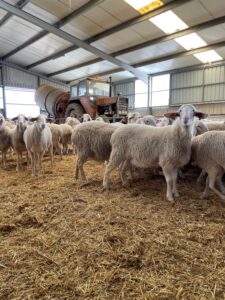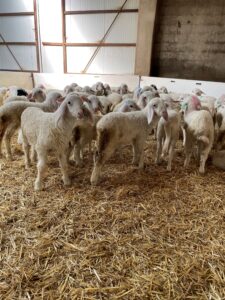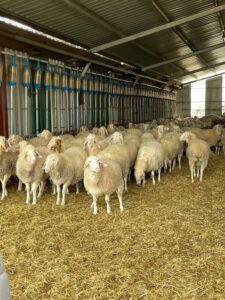– by C. Morgan-Davies (SRUC), G. Caja (UAB) and L. Riaguas (Oviaragón)
After TechCare held its annual meeting in Toro, Spain, on the 19th and 20th of February 2024, the Spanish partners (Gerardo Caja, UAB) and Leticia Riaguas (Oviaragón) organised visits to the Spanish large-scale study farms, where the technology retained by the project is being tested in commercial conditions.
On the 20th of February, we visited 2 dairy sheep farms. The first one, the HCM dairy sheep farm (Villavendimio, Zamora), is a medium size farm with an old shed. The owners, Francisco and Luz have 1200 animals, including 800 Assaf and Lacaune x Assaf ewes. They do not own any land, and all their feeds are bought in. They have 4 lambings per year (Jan-Apr-Jul-Oct) and use melatonin (summer) and sponges (spring) to synchronise their animals out of season. They use EID boluses and all information regarding the flock, its performance and movement is recorded, using a Datamars handheld recorder (GES3S). In the context of TechCare, they also have installed the Froggit weather station, with sensors inside the shed (8 pen temperature and humidity, 8 bedding humidity, 2 air quality) and outside (meteorological). All information relating to inside and outside data is recorded and sent to the farmer’s mobile phone and computer. They produce 400,000 litres of milk per year on average. They milk the ewes twice a day in a 2×12 milking parlour (low line, 24 milking units, frontal exit) and can milk 250 animals per hour with 2 workers. There is a manual milk recording every month, with samples for composition and SCC sent to the lab. All that information, as well as the welfare assessments that will be carried out, will be compiled for the TechCare project.


HCM ewes and lambs © Oviaragón
The second farm visited, FGG ovino (Villafranca de Duero, Valladolid), was a larger sized farm, run by Francisco, Mónica and their son Raúl. In 2005, they decided to change their system from a traditional outside grazing system to a more intensive indoors system with a low workload. They now have 1400 Assaf dairy ewes, and they are always trying to innovate on their farm, for their welfare and that of their animals. They also have 4 lambings per year, and employ 6 permanent workers, including 3 milkers. They have a 2×20 milking parlour (low line, 40 milking units, frontal exit), with automatic milk meters, automatic detached cups and use EID bolus reader panels at the entrance of both sides of the parlour, as well as an automatic pusher to guide the ewes to the milking parlour. They produce 700,000 litres of milk per year on average. They also use Datamars readers (GES3S) for information recording on the ewes and lambs, and have now installed the Froggit weather station, with sensors inside the shed (8 pen temperature and humidity, 8 bedding humidity, 2 air quality) and outside (meteorological). This is in addition to the DeLaval milk recording system they have. Like in the other farm, this recorded information will be used alongside the welfare assessments to inform the project.


FGG milking parlour and ewes © Oviaragón
The last farm visit was to the Oviaragón lamb feedlot, in Terrer on the 22nd February. Leticia and Victor, our Oviaragón partners, showed us their set-up, with their 2 feedlots comprising 160 pens, linked together by their reception area, where they weigh and split the animals. Each pen can hold 40 lambs, sorted by weight and sex. Each lamb has a visual tag. Like the 2 other large-scale study sites, this feedlot also has a Froggit weather station and indoor sensors sending information on a phone application and computer. Given that heat stress can be a big issue, this sensor information will be very useful for the project, once welfare assessments are also carried out.
